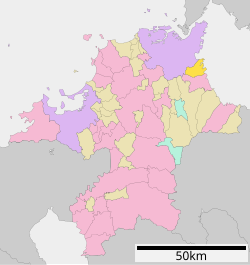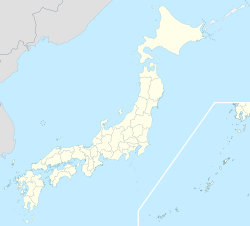Kanda (苅田町, Kanda-machi) is a town located in Miyako District, Fukuoka Prefecture, Japan. As of 30 April 2024[update], the town had an estimated population of 37,626 in 18,877 households, and a population density of 770 persons per km2. [1] The total area of the town is 48.98 km2 (18.91 sq mi).
Kanda
苅田町 | |
|---|---|
 Kanda Town Hall | |
 Location of Kanda in Fukuoka Prefecture | |
 | |
| Coordinates: 33°46′33″N 130°58′50″E / 33.77583°N 130.98056°E | |
| Country | Japan |
| Region | Kyushu |
| Prefecture | Fukuoka |
| District | Miyako |
| Area | |
| • Total | 48.98 km2 (18.91 sq mi) |
| Population (April 30, 2024) | |
| • Total | 37,626 |
| • Density | 770/km2 (2,000/sq mi) |
| Time zone | UTC+09:00 (JST) |
| City hall address | 1-19-1 Fukucho, Kanda-cho, Miyako-gun, Fukuoka-ken 800-0392 |
| Website | Official website |
| Symbols | |
| Flower | Pansy |
| Tree | Cinnamomum camphora |

Geography
editKanda is located in northeastern Fukuoka Prefecture. It is bordered by the Gulf of Suo on the Seto Inland Sea, and to the west by the Hiraodai, which is known for its karst plateau. The southern area adjacent to Yukuhashi City is a lush rural area on the Miyako Plain.
Neighboring municipalities
editFukuoka Prefecture
Climate
editKanda has a humid subtropical climate (Köppen Cfa) characterized by warm summers and cool winters with light to no snowfall. The average annual temperature in Kanda is 15.8 °C. The average annual rainfall is 1663 mm with September as the wettest month. The temperatures are highest on average in August, at around 26.8 °C, and lowest in January, at around 5.2 °C.[2]
Demographics
editPer Japanese census data, the population of Kanda has been steadily increasing since the 1950s.
| Year | Pop. | ±% |
|---|---|---|
| 1950 | 13,731 | — |
| 1960 | 18,796 | +36.9% |
| 1970 | 22,430 | +19.3% |
| 1980 | 26,058 | +16.2% |
| 1990 | 32,850 | +26.1% |
| 2000 | 34,931 | +6.3% |
| 2010 | 35,827 | +2.6% |
| 2020 | 37,309 | +4.1% |
History
editThe area of Kanda was part of ancient Buzen Province. During the Edo Period, the area was part of the holdings of Kokura Domain. The village of Kanda within Miyako District, Fukuoka was established on May 1, 1889, with the creation of the modern municipalities system. Kanda was raised to town status on August 1, 1924. Kanda annexed neighboring the villages of Obase and Shirakawa on January 1, 1955.
Government
editKanda has a mayor-council form of government with a directly elected mayor and a unicameral town council of 11 members. Miyako, collectively with the town of Kanda contributes one member to the Fukuoka Prefectural Assembly. In terms of national politics, the town is part of the Fukuoka 11th district of the lower house of the Diet of Japan.
Future merger
editA majority of local residents favor remaining an independent municipality, but voices calling for a merger with the neighboring city of Kitakyūshū remain.[3]
Economy
editKanda belongs to the Kitakyushu metropolitan area and serves partly as a commuter town with neighboring Kitakyushu City and Yukuhashi City. It is part of the Kitakyushu industrial zone (region) centered on automobiles, cement, electricity, etc., and has a large concentration of industry compared to its population size. In recent years, the automobile industry has become extremely concentrated, with the Nissan Motor Kyushu Plant (currently Nissan Motor Kyushu) starting operations in 1975 and the Toyota Motor Kyushu Kanda Plant starting operations in 2005.[4] It is developing as an area that is responsible for the automobile industry in northern Kyushu.
Education
editKanda has six public elementary schools and two public junior high schools operated by the town government and one combined public high school operated by the Fukuoka Prefectural Board of Education. The Nishinippon Institute of Technology is also located in Kanda.
Transportation
editAirports
edit- Kitakyushu Airport (the airport terminal is located in Kokuraminami-ku, Kitakyūshū; however half of the artificial island on which it is built is within the borders of Kanda. [5]
Railways
editHighways
editSister cities
edit- Samcheok, South Korea, since 1997
Local attractions
edit- Goshoyama Kofun, National Historic Site
- Ishizukayama Kofun, National Historic Site
- Seiryu Cave, National Natural Monument
Festivals
edit- Kanda Float Festival, held annually in mid-September.[7] The festival is famous for its 14 "fighting floats", and has been categorized as an "Intengible Folk Cultural Asset" by the Fukuoka prefecture.
References
edit- ^ "Kanda Town official statistics" (in Japanese). Japan.
- ^ Kanda climate: Average Temperature, weather by month
- ^ "振興から自立へ 苅田町の挑戦<中>連携 聞こえてくる不協和音". Archived from the original on 2011-09-27. Retrieved 2009-11-19.
- ^ "Nissan Kyushu Plant history". Archived from the original on 2015-07-23. Retrieved 2015-07-18.
- ^ "Welcome to Kitakyushu airport official website". english.kitakyu-air.jp. Retrieved 2019-08-30.
- ^ "Higashi-Kyushu Expressway Kanda Kitakyushu Airport IC Inbound Exit Details / Explore| Japan Travel by NAVITIME - Japan Travel Guides, Maps, Transit Search and Route Planner". japantravel.navitime.com. Retrieved 2019-08-30.
- ^ Japan, Kyushu Tourism Promotion Organization [. "KANDA FLOAT FESTIVAL|EVENT INFORMATION|Kyushu Tourism Information [ Japan ]". Kyushu Tourism Information [ Japan ] (in Japanese). Retrieved 2019-08-30.
External links
edit- Media related to Kanda, Fukuoka at Wikimedia Commons
- Kanda official website (in Japanese)


